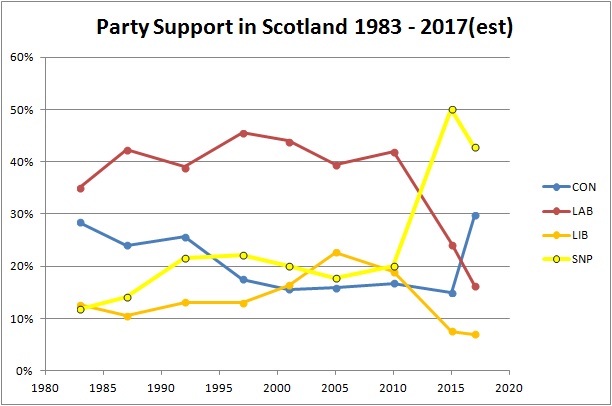This promises to be a seismic election, not just throughout Britain, but also in Scotland. At the last election, the SNP were triumphant, despite (or because of) losing the independence referendum eight months earlier. They won all but three of Scotland's 59 seats pushing Labour into second place in terms of votes cast.
The Conservatives have not been seen as a strong party in Scotland. They were third in 2015, and were the fourth party in Scotland behind the Lib Dems for the three elections before that. Some think this is the natural order in Scotland, that is always has been and it always will be.
But going back further, the Conservatives were more popular. In 1983, under Margaret Thatcher, they were only 7% behind Labour overall. Excluding Labour's Glasgow citadel, they actually got more votes than Labour in the rest of Scotland. That is not a fact that many in Scotland remember of talk about. Thatcherism is remembered as something the English did to the Scots, not something that 800,000 Scots voted for.
What is happening now in Scotland? It's hard to be entirely sure, because Scottish polling is fairly scant. There were only three polls taken in April since the election was called. But YouGov published a fourth poll this weekend, so a trend is now becoming visible.

If the polls are to be believed, the Conservatives are back in contention. They are now in second place at around 30pc. That is well behind the SNP on 43pc, but also well ahead of Labour on 17pc. The Liberal Democrats are languishing on 7pc, though they have traditional pockets of strength.
The SNP have discovered that if you have climbed to the top of the mountain, then there is only one direction you can go next. They are still dominant and predicted to win over two fifths of Scottish voters, and to win most of the seats. But it is likely not to be as great a victory as in 2015, and they may lose around nine seats to the Conservatives.
The transformation of Scottish Labour is worth a moment to reflect upon. It used to dominate the Scottish political scene and produced power-house politicians on the national scene like John Smith, Gordon Brown, John Reid and Alistair Darling. Now it is reduced to a single seat, and is in danger of losing even that.
Even ignoring the polling uncertainty for a moment, the result has further electoral uncertainty. Due to the Scottish electoral geography, a much larger proportion of the seats are marginal than in the rest of the country. Around one fifth of Scottish seats have a predicted small majority, compared with just one-in-ten seats in England and Wales. A small majority is defined as less than 5% or around 2,500 votes.
That makes a dozen seats which could go either way. And these include some notable seats. Most significant is Moray, which is held by the SNP deputy leader Angus Robertson. Known for his trenchant performances at Prime Minister's Question Time, Robertson has a fight on his hands for this highland seat which voted more Leave in the EU Referendum than the rest of Scotland.
Some other high-profile SNP names are in very marginal seats. Pete Wishart's seat of Perth and North Perthshire has the SNP and the Conservatives within around 1pc of each other. And in Dunbartonshire East, John Nicolson is fighting the Liberal Democrats with a similar margin between them.
The city of Edinburgh is also a swing city at this election. Apart from Edinburgh East, its other four consituencies all have predicted majorities of less than 1,700 votes (3.5pc). This includes the bell-weather Edinburgh South, which is currently Labour's only seat in Scotland. In 2015, many natural Conservatives in the suburbs around Morningside voted tactically to keep the SNP out. Though this time it is predicted to be a three-way marginal with the Conservatives edging it ahead of Labour and the SNP. But as a strongly "Remain" city, Edinburgh may not prove so fruitful for the Conservatives. This is one to watch out for on election night.
The current prediction is that the Conservatives will go up from the current single seat (Dumfriesshire, Clydesdale and Tweeddale) to around 11 seats. But the marginal seats add sizeable uncertainty to this. There are 6 marginal seats which the Conservatives are tipped just to win, and another 4 marginal seats which they are tipped just to lose. Taken together, that means the Conservatives could get anywhere between 5 and 15 seats. It is that close.
On the SNP side, there is similar arithmetic. The central prediction is for 47 seats, but 6 of those are marginal holds and another 5 are marginal losses. So their range of likely outcomes runs from 41 to 52 seats.
And any polling error could change this situation further.
It will be a very interesting election night in Scotland, but one thing is already clear. The Conservatives are back in Scotland, and Labour is fighting for relevance, whilst the SNP are still the most popular party.